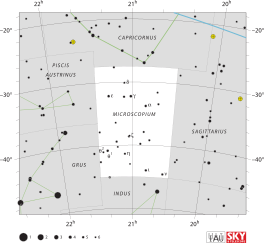Gamma Microscopii
| Gamma Microscopii
| ||||

| ||||
| Die ligging van Gamma Microscopii (in die rooi sirkel). | ||||
| Sterrebeeld | Mikroskoop | |||
| Spektraaltipe | G6 III[1] | |||
| Soort | Reusester | |||
| Waarnemingsdata (Epog J2000) | ||||
| Regte klimming | 21h 01m 17.46047s[2] | |||
| Deklinasie | -32° 15′ 27.9574″[2] | |||
| Skynmagnitude (m) | 4,680[3] | |||
| Absolute magnitude (M) | 0,49[4] | |||
| B-V-kleurindeks | +0,882[3] | |||
| U-B-kleurindeks | +0,575[3] | |||
| Besonderhede | ||||
| Massa (M☉) | 2,5[5] | |||
| Radius (R☉) | 10[5] | |||
| Ligsterkte (L☉) | 64[5] | |||
| Ouderdom (jaar) | 620 miljoen[5] | |||
| Temperatuur (K) | 5 050[6] | |||
| Afstand (ligjaar) | 223 | |||
| Metaalinhoud [Fe/H] | -0,22 ± 0,11[7] | |||
| Ander name | ||||
| CD−32 16353, CPD−32 6269, FK5 1550, GC 29331, HD 199951, HIP 103738, HR 8039, SAO 212636, WDS 21013-3215A.[8][9] | ||||
| ||||
Gamma Microscopii (afgekort as γ Mic) is die helderste ster in die sterrebeeld Mikroskoop (Microscopium).[5] Dit het ’n skynbare magnitude van 4,68,[3] wat te dof is om uit stadsgebiede te sien. Volgens parallaksmetings is dit sowat 223 ligjare van die Son af.
Eienskappe[wysig | wysig bron]
Die ster se sterreklassifikasie is G6 III,[1] wat beteken dit is ’n G-tipe reusester. Dit verbrand helium in sy kern en is deel van die rooiklonttak, hoewel sy metaalinhoud (die elemente swaarder as waterstof en helium) laag is vir ’n lid van dié groep sterre.[7] Sy effektiewe temperatuur is 5 050 K,[6] wat dit die tipiese geel kleur van ’n G-tipe ster gee.[10]
Dit is al ’n moontlike lid van die Ursa Major-groep sterre genoem wat ’n oorsprong en beweging deur die ruimte deel.[4] Die ster was omtrent 3,8 miljoen jaar gelede sowat 6 ligjare van die Son af.[11] Dit sou toe ’n skynbare magnitude van -3 gehad het en helderder gewees het as wat Sirius nou is.[5] Sowat 3,9 miljoen jaar gelede het dit waarskynlik binne 1,14 tot 3,45 ligjare van die Son verbybeweeg – moontlik naby en groot genoeg om die Oortwolk te versteur.[12]
Gamma Microscopii het ’n visuele dubbelstermetgesel, CCDM J21013-3215B, teen ’n hoekskeiding van 26 boogsekondes. Dié ster het ’n skynbare magnitude van sowat 13,7.[9]
Naam[wysig | wysig bron]
Johann Bayer het nie self die Bayer-naam γ Microscopii aan die ster gegee nie – dit het die Flamsteed-naam 1 Piscis Austrini gehad voordat Nicolas-Louis de Lacaille die sterrebeeld Mikroskoop in 1756 geskep het.[13]
Verwysings[wysig | wysig bron]
- ↑ 1,0 1,1 Montes, D. et al. (November 2001), "Late-type members of young stellar kinematic groups - I. Single stars", Monthly Notices of the Royal Astronomical Society 328 (1): 45–63, doi:10.1046/j.1365-8711.2001.04781.x, Bibcode: 2001MNRAS.328...45M, archived from the original on 22 September 2017, https://web.archive.org/web/20170922053238/http://eprints.ucm.es/30941/1/castrorubio18libre.pdf, besoek op 20 Junie 2019
- ↑ 2,0 2,1 van Leeuwen, F. (November 2007), "Validation of the new Hipparcos reduction", Astronomy and Astrophysics 474 (2): 653–664, doi:10.1051/0004-6361:20078357, Bibcode: 2007A&A...474..653V
- ↑ 3,0 3,1 3,2 3,3 Jennens, P. A.; Helfer, H. L. (September 1975), "A new photometric metal abundance and luminosity calibration for field G and K giants.", Monthly Notices of the Royal Astronomical Society 172: 667–679, doi:10.1093/mnras/172.3.667, Bibcode: 1975MNRAS.172..667J
- ↑ 4,0 4,1 King, Jeremy R. et al. (April 2003), "Stellar Kinematic Groups. II. A Reexamination of the Membership, Activity, and Age of the Ursa Major Group", The Astronomical Journal 125 (4): 1980–2017, doi:10.1086/368241, Bibcode: 2003AJ....125.1980K
- ↑ 5,0 5,1 5,2 5,3 5,4 5,5 Gamma Mic, Stars, Jim Kaler. Besoek op 19 Maart 2015.
- ↑ 6,0 6,1 McWilliam, Andrew (Desember 1990), "High-resolution spectroscopic survey of 671 GK giants. I - Stellar atmosphere parameters and abundances", Astrophysical Journal Supplement Series 74: 1075–1128, doi:10.1086/191527, Bibcode: 1990ApJS...74.1075M
- ↑ 7,0 7,1 Kubiak, M. et al. (June 2002), "Metal Abundance of Red Clump Stars in Baade's Window", Acta Astronomica 52: 159–175, Bibcode: 2002AcA....52..159K
- ↑ Simbad. Centre de données astronomiques de Strasbourg http://simbad.u-strasbg.fr/simbad/sim-basic?Ident=HD+20794.
{{cite web}}: Ontbrekende of leë|title=(hulp), SIMBAD. Besoek op 20 November 2008. - ↑ 9,0 9,1 Entry 21013-3215, The Washington Double Star Catalog, United States Naval Observatory. Besoek op 20 November 2008.
- ↑ "The Colour of Stars", Australia Telescope, Outreach and Education (Commonwealth Scientific and Industrial Research Organisation), 21 Desember 2004, archived from the original on 2012-03-10, https://www.webcitation.org/6630AbtJZ?url=http://outreach.atnf.csiro.au/education/senior/astrophysics/photometry_colour.html, besoek op 2012-01-16
- ↑ García-Sánchez, J.; Weissman, P. R.; Preston, R. A.; Jones, D. L.; Lestrade, J.-F.; Latham, D. W.; Stefanik, R. P.; Paredes, J. M. (2001), "Stellar encounters with the solar system", Astronomy and Astrophysics 379 (2): 634–659, doi:10.1051/0004-6361:20011330, Bibcode: 2001A&A...379..634G, http://www.aanda.org/articles/aa/pdf/2001/44/aah2819.pdf
- ↑ Bailer-Jones, C. A. L. (2015). "Close encounters of the stellar kind". Astronomy & Astrophysics. 575: 13. arXiv:1412.3648. Bibcode:2015A&A...575A..35B. doi:10.1051/0004-6361/201425221. A35.
- ↑ Wagman, M. (Augustus 1987). "Flamsteed's Missing Stars". Journal for the History of Astronomy, Vol.18, NO. 3/AUG, P.209, 1987. 18: 220. Bibcode:1987JHA....18..209W. doi:10.1177/002182868701800305.
Bronne[wysig | wysig bron]
 Hierdie artikel is vertaal uit die Engelse Wikipedia
Hierdie artikel is vertaal uit die Engelse Wikipedia
